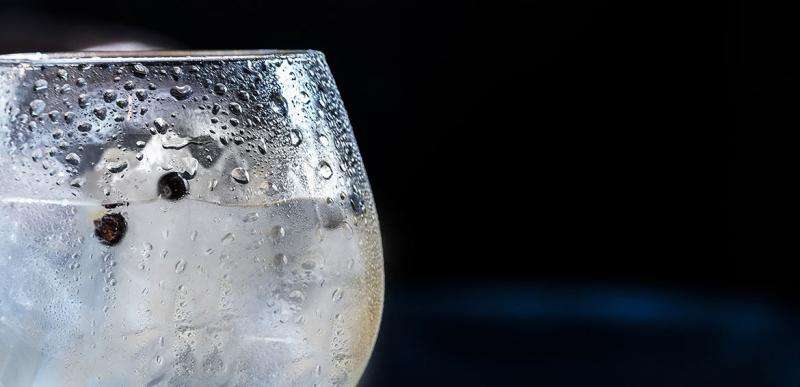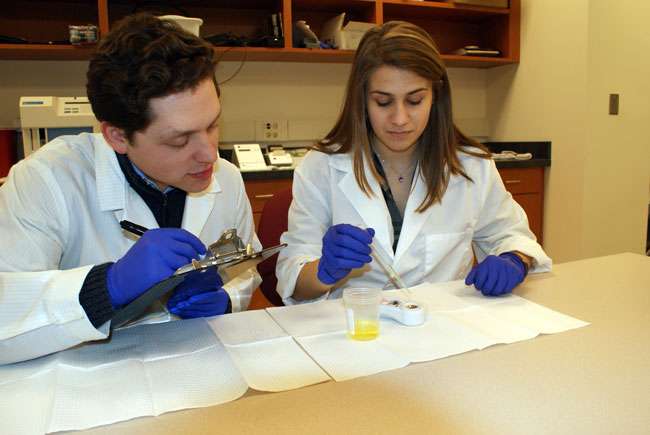A patent to prevent dehydration

Preventing dehydration is simple. Drink fluids, and plenty of them. But dehydration has a way of sneaking up on you, especially during the warmer summer months, and it can be hazardous when it does. For the average person, the threat of intermittent mild dehydration is not usually a cause for concern because one's hydration level is always in constant flux. But even mild dehydration can have a negative impact on those who are the most susceptible to heat injury, such as athletes, outdoor laborers, children, and even the elderly.
Health Sciences Prof. Dan Drury is working on a solution to prevent dehydration before it becomes dangerous.
"Diagnosing dehydration isn't accomplished by observing just one factor, it's really a collection of interrelated factors," said Drury. "Decreased urine output, sweat rate, thirst, disorientation—many different things can collectively indicate someone is dehydrated."
During daily activities, it isn't always easy to determine whether or not someone is dehydrated. One of the simplest indicators to observe is urine color. In general terms, the darker it is, the more dehydrated you probably are at that time. In a doctor's office or research laboratory, you may be asked to provide a urine sample, which would then be compared to a standardized dehydration color chart. But Drury has patented a system that would allow you to self-analyze your own urine color by comparing it to a color scale placed inside the toilet or urinal—no need to touch or handle the sample.
It's not only user friendly, said Drury, but it also provides an important visual reminder that can be used with every visit to the restroom.
"Athletes and workers often don't know if they're dehydrated," said Drury. "With this intra-urinal color scale, any person, athlete, or senior can easily check the concentration and color of their urine on a daily basis. It's just one of the clues used to identify dehydration, but dark-yellow concentrated urine can serve as a reminder so someone can make better daily fluid intake decisions and stay hydrated."
This past semester, Nicole Beyer '16 and Lee Friedman '16, both Health Sciences majors, worked with Drury to determine if the new system helped people accurately self-diagnose their hydration levels. They collected samples from male volunteers on campus and asked them to determine their level of hydration using the sticker inside the urinal. Then, they compared the intra-urinal color scores obtained from the subjects to a clinical urine specific gravity value that was analyzed using a spectrometer. They found that using the intra-urinal sticker enabled participants to correctly assess their level of hydration better than using the traditional educational color chart currently on the market.

"With an accurate identification, people can take preventative steps to ensure their dehydration doesn't progress and cause negative health outcomes," said Beyer, who is currently completing an accelerated nursing program at Thomas Jefferson University in Philadelphia.
"In nursing school, a lot of focus is put on prevention instead of waiting to treat complications, and this scope of research embodies that," she said. "If dehydration is identified early, it can be promptly self-treated and negative effects can be easily avoided."
Like Beyer, Friedman plans to enter the medical field and is currently working as a medical assistant while preparing to apply to medical school. He said he learned skills that he will take with him there.
"The most important lesson I'm going to take away is how to create an experiment from scratch," Friedman said. "Prof. Drury let us really build this experiment from the ground up. He was there to guide us and let us know what we needed to do, but it was up to Nicole and I to write the procedures, make hypotheses, and design the research."
"It's not like a traditional class where students come to class or lab at a specific time each week and we conduct a pre-determined activity," said Drury. "[Friedman and Beyer] would meet with me in my office as part of a team and we worked together to come up with a weekly research action plan."
Drury plans to continue this research with new students in the fall. Ultimately, he hopes to expand its scope, developing a female version of the product (right now the sticker is designed specifically for urinals) and an easy-to-use urinal screen that utilizes a similar color scale.
"The beauty of the product and process isn't in its complexity—it's in its utility, simplicity, and accessibility," Drury said. "The intent is to prevent dehydration in different populations by providing a field measurement of one's hydration that is accessible, easy to use, and functional."

















